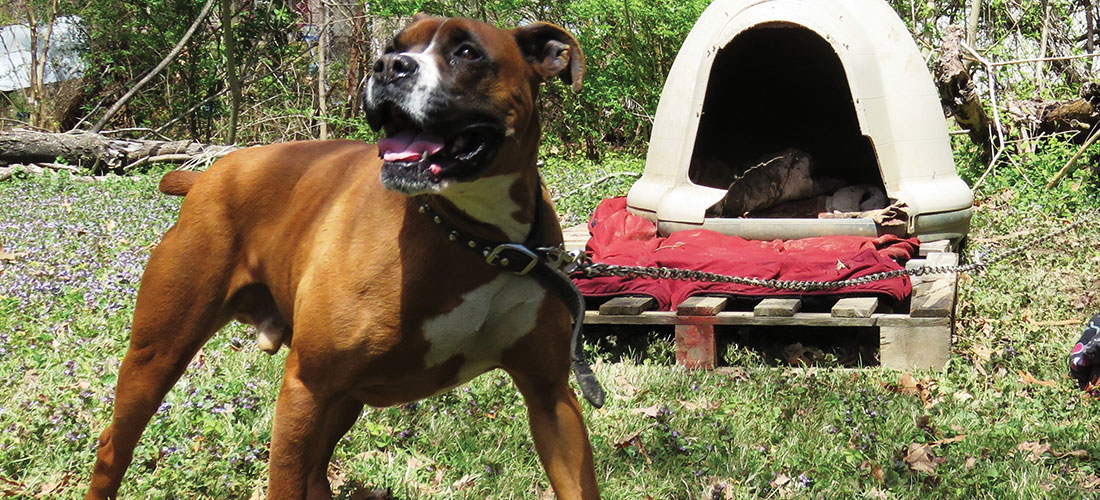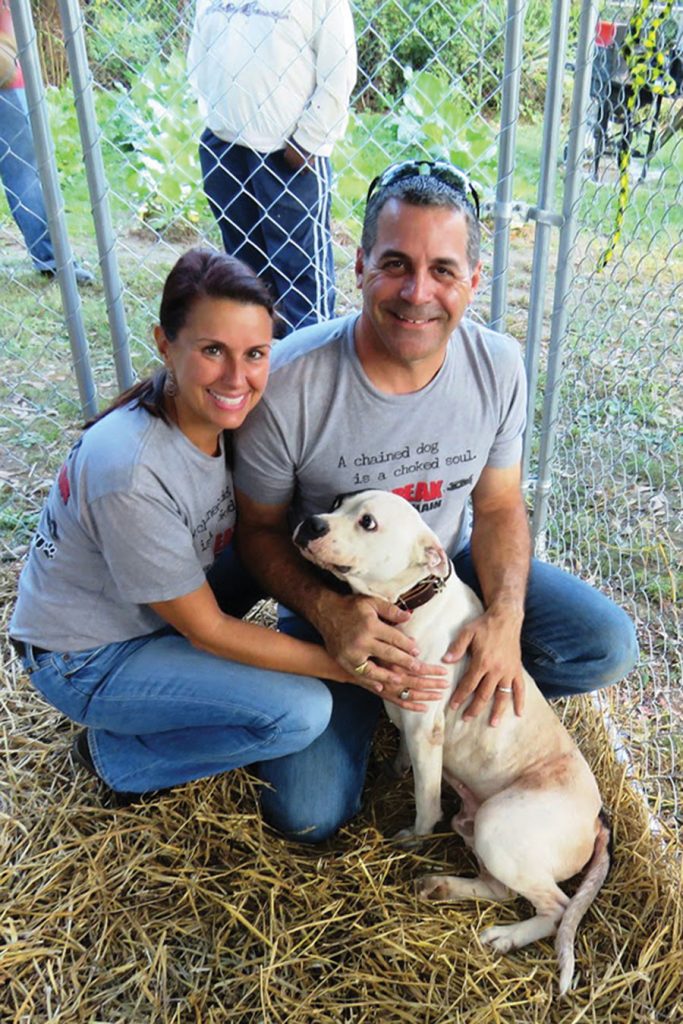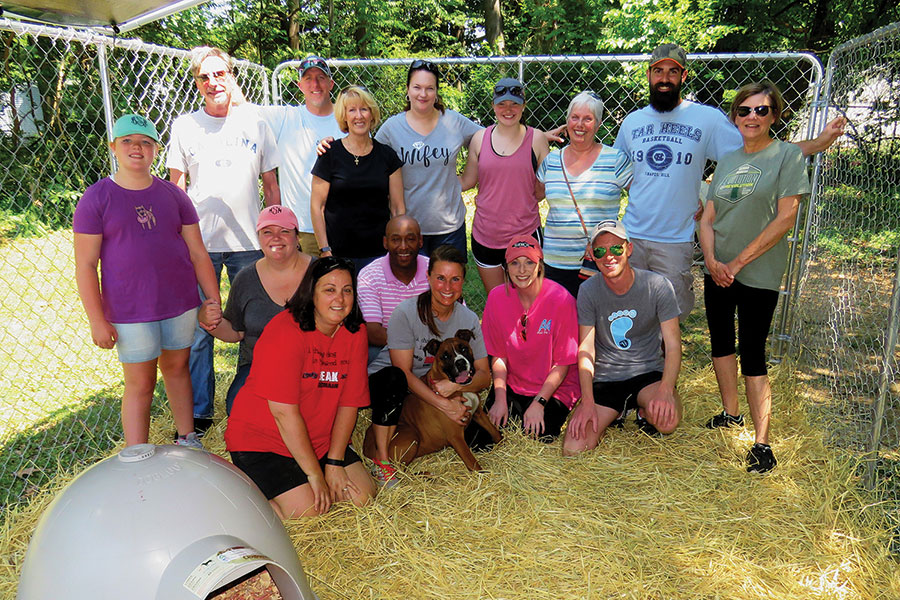
Unchained Melody
How Break the Chain is breaking new ground in caring for dogs
By Billy Ingram
“Absolutely not, we are not bringing a dog into this house.” That was Dad’s predictably visceral reaction after a neighborhood teenager rang our doorbell late one night, cradling a newborn puppy in the palm of his hand, one he’d found whimpering unaccompanied down the sidewalk. Our neighbor believed, correctly as it turned out, that a puppy would be a natural addition to a home with young kids and no pets. Dear Old Dad didn’t see it that way. But with three chirping birds pleading to adopt that wide-eyed orphan, he finally gave in.
We named her Molly, and she spent the first night in the kitchen howling and crying. When we got her back from the veterinarian late the next day, it was my father who was howling and crying, that skin-and-bones pup was, by weight, more worms than dog. Although he made more than a decent living, our father was raised a country boy during the Depression and found it difficult to accept that, “I just spent $200 on a beagle mutt!”

When Molly needed to do her business, we would just open the back door to let her out. We lived on Blair Street, across from what is now Bill Craft Park, so it seemed like a reasonable idea. Except, for some unknown reason, Molly had a penchant for roaming one block up to Hammel where our aunt lived, baying incessantly outside her back door. As a result, our dog would get snatched up by Animal Control. A lot. So we fenced in the backyard, with wooden posts to disguise the chain links. Not that Molly didn’t — all too often — tunnel her way out so she could howl away at that aunt she was weirdly fixated on.
I hadn’t thought about that adorable pooch in years. Not until, on the road to High Point, Sylvia Mayon turned to ask, “Are you a dog person, Billy?” I replied somewhat reluctantly, “Not really. I mean, I loved our mutt Molly growing up but, to be honest, I only like my own animals.”
Doris Day I’m not. But this isn’t a story about dogs, per se. It’s about a local power couple, Andrew and Sylvia Mayon, who created Break The Chain Kennel Kru to identify dogs habitually chained to one spot in someone’s backyard. The nonprofit’s goal is to build for them a deluxe, well-appointed kennel so that animals can experience some level of freedom.
The Mayons came up with Break the Chain 2 1/2 years ago. Together with a cadre of determined volunteers, this nonprofit has erected more than 50 canine habitats. “I always got angry when I saw dogs at the end of a chain,” Sylvia explains. “We had volunteered with Project Heart where we delivered dog houses, educated owners on spay and neuter, but when we left, that dog was still on a chain. Instead of being angry all the time, I wanted to do something about it.”
Some ways these dogs are tethered can be inexplicably cruel as Andrew told me, “These chains can be heavy, metal logging chains weighing down their necks that can get wrapped around a tree, causing the animals to be protective of a very short space.”
How does a dog end up this way, confined for a decade or even their entire lives, I asked as we were on the way one Saturday afternoon to erect a kennel for a Gulf War veteran’s pet. Sylvia told me, “Many times, as in this case, the dog was abandoned by its owner and someone stepped up to save that animal from the shelter,” Sylvia adds. “In their mind they’ve ‘rescued’ a dog from being euthanized.”
“We’ve heard it all,” Sylvia laments. “One dog owner said, ‘He’s our alarm system.’ We told him, ‘We have three big dogs and they all live inside and they know when Andrew is coming home from a block away. So they can be an alarm system from inside the house as well.’ I mean, they’re not going to be able to do much on a chain or in a kennel.”
“Some people have just grown up with a dog on a chain,” Andrew adds. “It’s just the way they’ve always known it. Grandma and Grandpa had their dog on a chain, Mom and Dad had their dog on a leash.”

That’s where another major portion of their mission comes into play. “We are so much more than unchaining dogs,” as Sylvia says. “A lot of it is education and providing resources.” She tells me that spay/neuter is the No. 1 requirement, and that all pets in the household have to be fixed. Then to qualify for this service, clients must be on some form of governmental assistance or low income.” That does not automatically qualify someone for a kennel however. “I do a phone interview first,” she says. “I have a questionnaire where I can get a better idea of the situation.” Once she determines they might be a good candidate for our program I will do a home visit with another volunteer. That way, Sylvia continues, “We can actually see the situation and meet the owner, meet the dog. If they’re looking just to get a free kennel and then not see us anymore, that is not part of our program.”
They’ve partnered with Project B.A.R.K., an organization that offers to spay/neuter for $10 or $15 depending on the size of the dog. This must be paid by the owner. “That’s crazy inexpensive, but it gives them some skin in the game,” Andrew explains. “Many of these dogs have never been to a vet, never had their shots. So we have a great relationship with Benessere Animal Hospital. The hospital provides other low-cost services, he says. “I did not want to go unchain a dog then build the kennel, walk away, and know that that dog might be dying of heartworms. Dr. [Janine] Oliver [Benessere’s owner] has been a part of our journey since the very beginning because she believes in our mission.”
Their commitment involves making home visits every four to six weeks, plus providing replacement straw and dog food for owners who that are disabled or lack transportation. Volunteers will even take one of these pets home for a night so they can experience for the first time what it’s like to sit on a couch or sleep on a bed. If a pooch is outside due to bad behavior in the home, Break the Chain will hire a trainer. “We try to get the dog integrated back with the family,” Andrew says. “Most of them are pit bulls, pit-bull mixes, so I like to show the softer side. Just because they’re on a chain and they’re a pit mix does not mean they’re a bad dog.”
Arriving at our destination, a tidy mid-century home in High Point, we meet Bronx, a pit mix abandoned when his previous owner relocated to another state. That sweet boy could not have been friendlier or more enthusiastic, bounding about excitedly, reveling in the attention from the 16 folks gathered to build his pen.
Although this Saturday afternoon’s crew was largely made up of novices like myself, the whole enterprise was quite enjoyable. The 10’ x 20’ kennel was easily assembled and then outfitted with a new igloo, straw flooring, water and food bowls, pooper scooper, and an overhead tarp for shade and weather protection. Inside the igloo they spread cedar chips, a natural flea and tick repellant.
Many of the Kru were friends and coworkers of Edward Jones employee Cathy Johnson Deal, who had recently passed away at a young age. With her daughter Taylor in attendance, a commemorative plaque was placed on the kennel door in Cathy’s honor.
That leisurely but emotionally charged endeavor took about an hour. “With the regular crew we can set up in as little as 15 minutes,” Andrew says. “For us it’s not about how fast to get the kennel up, it’s spending time with the owner, getting to know the dogs. That’s what builds trust. When you have a connection, hopefully they will be more apt to listen and take your suggestions.”
Sylvia gave me some background as we’re were packing up the tools, “This dog [Bronx], you didn’t see him tied to the tree like I did with blankets in his igloo. Which was a teaching moment. When we did the home visit, the temperatures were freezing. What the owner didn’t realize is that those blankets absorb the moisture, so basically the dog was lying on ice. And right away, as we were leaving, [Bronx’s owner] Charles removed all the blankets.”
Afterward, everyone congregates at a nearby restaurant, as is custom, for fellowship and to discuss that day’s effort. If indeed you are judged by the company you keep, Cathy Johnson Deal must have been a truly splendid person.
On the trip back to Greensboro, the Mayons recalled for me their first build, for William Jones, now a member of Break the Chain’s board of directors. While he had been very much attuned to his dog’s needs, Animal Control had been out to warn him about a new tethering ban that levies a $500 fine.
Sylvia met with Jones and, “I was so impressed by William I said to Andrew, ‘What do you think if we send out an email to a few of our friends and we raised enough money to build his dog Cash a kennel?’ And Andrew said, ‘Let’s do it.’ In three days we raised the $500 needed.” She laughs remembering, “Mind you Andrew and I had never seen a kennel close up. It took us 3 1/2 hours to build that kennel.” That was before they discovered you could assemble one with panels like they do today, “Once we saw Cash lie down in that straw it literally brought tears to my eyes,” she says.
“As we were building Cash’s kennel we looked over and two backyards down was another dog on a chain named Fido. His owner came out and asked what we were doing and I told him and, on the spot I said, ‘What if I raise the money to build Fido a kennel, would you get him neutered?’ and he said, ‘Absolutely.’ We got back to the car and I said, ‘I just found my purpose in life.’”
If a client moves, the kennel is theirs to take with them. The team will even assist with that. If there comes a point where someone doesn’t need it anymore, the kennel will be repurposed for another dog. The Mayons have only had one person sell a kennel out from under them.
Referrals may come from a neighbor of a recipient or from Animal Control when someone has called them out about a chained dog. If they feel the family might be a good prospect for Break the Chain, Animal Control will give them a flyer about the program.
Although approached many times to franchise the operation, Andrew demurs, “We tell them no, we’re not interested, but we’ll be happy to share the concept and tell them how to do it. Break the Chain is just us, just Guilford County.” Sylvia adds, “I’m very detail- oriented, so to me it’s not how many dogs we can unchain, it’s the whole experience. I want it all to be a class act.” With so many components at play, this outreach consumes several hours every day. “We try to do a build every other weekend but we also have straw deliveries going out and transporting dogs to the vet for emergency surgery.”
Days after his kennel was erected, Bronx was one tail-wagging, happy pup as he left Benessere Animal Hospital with all of his shots and his first bath. They even boarded him for a couple of days so he didn’t have to be out in one of those thunderous storms we had a few months back.
Folks from all around the country, along with corporate sponsors, fund this worthy operation. Andrew is proud to say, “Every dime goes into our builds. We don’t buy dinners or fuel the car with donations.” I can testify to that! OH
How can you help freedom-loving animals from these torturous conditions? Make a generous tax deductible gift at btckennelkru.org or hit the email link there and ask how you can best contribute to this cause.
The author of five books and creator of TVparty.com, Billy Ingram is, in the words of the L.A .Times, “one of the nation’s top pop culture gurus.”





